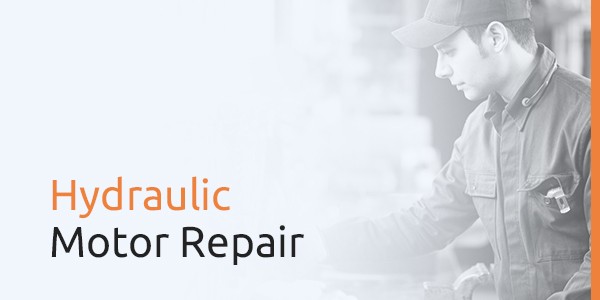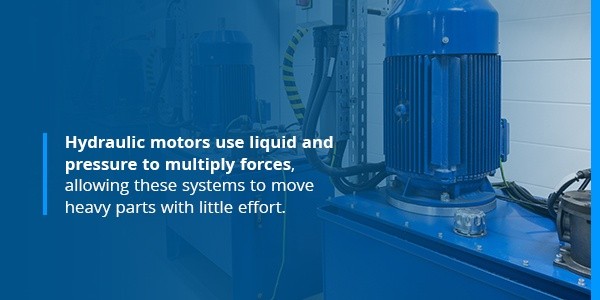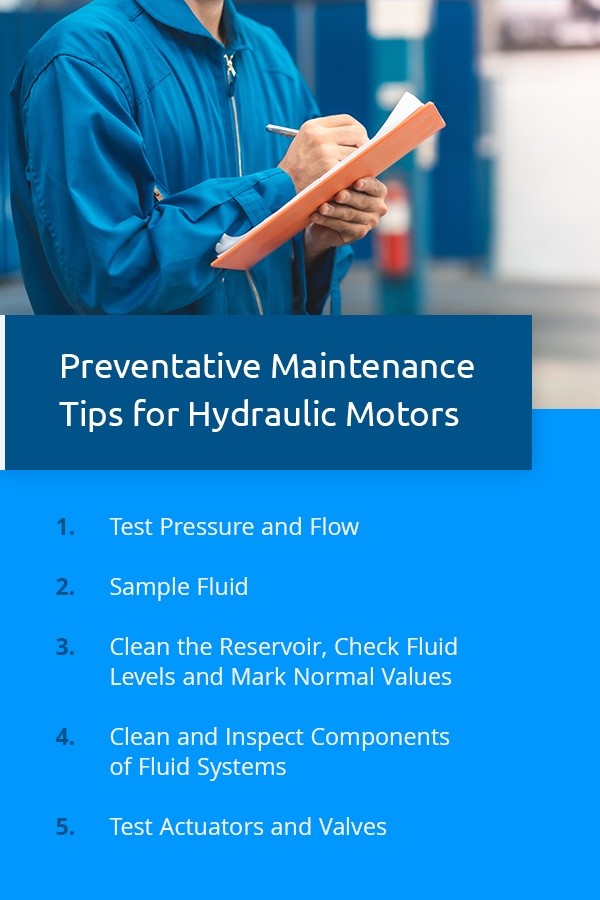Hydraulic Motors

Hydraulic Motor Repair
Hydraulic motors are commonly used in applications where the power source is a hydraulic system, and it is not viable or cost effective for there to be electrical present. These motors are useful because they can handle extremely high loads for their size. Hydraulic repair services involve attending to complex motors that require various forms of expertise. When your business needs repairs to hydraulically operated devices, contact experts who understand these motors and efficient ways to extend their lives.
Our Hydraulic Motor Repair Services
When companies send their hydraulic motors to us for repairs, we send the devices through an extensive process to ensure we make all necessary repairs and restorations. Our approach to repairs looks beyond fixing one broken component to refresh and restore the entire hydraulic motor, thereby extending its life and efficiency. Our process includes the following steps:
1. Disassembly
First, we must take apart the motor to access its various components. Our disassembly process is carefully controlled to prevent damage to the parts and ensure everything has a thorough examination. This removal and inspection of the motor’s components helps our technicians determine which parts need cleaning and restoration.
Some of the components we inspect and may repair or replace include:
- Sealing components, such as gaskets, o-rings and seals
- Hardware, such as screws, bolts, washers and other fasteners
- Gears, especially those with wear, backlash or broken teeth
- Oil seals on shaft ends
2. Cleaning
Next, we clean and inspect each part. For hydraulic motors that have fluid or oil constantly flowing over parts, removing oil buildup allows us to more closely evaluate the condition of the motor parts. Hydraulic oil, fluid or cleaning agents can contaminate the interior of a hydraulic motor. Cleaning off these contaminants can reduce friction and improve the efficiency of the motor.
3. Testing Electronics
Electronics that regulate the motor operation require inspection and testing. With this step, the technician can better find the source of motor issues. In some cases, the motor may only require repairs of the electronics to restore operation.
4. Restoring Moving Parts
Over time, the constant movement of pistons and shafts can lead to surface scoring. Our technicians have several methods available to remove the scoring. Occasionally honing or polishing will remove minor pitting and scoring. For more serious cases, we can recoat the surface with chrome.
Just as we work to restore the pistons and shafts, we do the same for cylinders and any other contact points. We may need to machine damaged cylinders or replace broken shafts in them. Lastly, for gear motors, we examine the integrity of the teeth and replace worn or damaged gears to restore operation.
5. Replacing Bearings and Worn Seals
All seals, bearings and gaskets that show signs of wear will have new parts installed to replace them. Worn components such as these can cause fluid leaks that compromise the efficiency of the entire motor operation.
6. Verifying Tolerances of Fittings and Testing
Because hydraulic motors rely so heavily on pressure and flow, we must check the tolerances of fittings to ensure the system can create and maintain the required pressure. Some tests we do include a pressure test and specification test up to 1,000 pounds per square inch (psi) pressure and 150 gallons per minute (gpm) flow.
After replacing all the restored parts, we test the unit at a known rpm to verify it meets proper torque and pressure requirements.
How Hydraulic Motors Work

Hydraulic motors use liquid and pressure to multiply forces, allowing these systems to move heavy parts with little effort. Hydraulic motors differ from hydraulic pumps in that instead of converting the mechanical energy into pressure and flow, they convert pressure and flow into mechanical energy. A hydraulic motor usually needs a pump as one of its components to ensure it has a properly pressurized flow of oil or fluid.
Generally, hydraulic motors fall into one of three categories — gear, vane and piston motors. All types of hydraulic motors have either fixed or variable displacement. Fixed displacement has a constant torque and speed whereas the variable displacement can create different speeds and torque — or twisting force.
Gear Motors
Generally, gear motors have the most cost-effective prices and work optimally when operated with medium flows and pressures. These types of hydraulic motors use a pair of gears — the idler gear and the driven gear. The driven gear connects to the output shaft to create the work needed as this gear turns.
To operate, high-pressure hydraulic oil moves into the gear housing and around the gears. A naturally created pressure differential between the high-pressure incoming oil and the low-pressure outlet keeps oil in the system. However, this type of motor requires close monitoring and maintenance to avoid oil leakages. The most common components to fail in these types of motors are the bushings and housing, which wear out long before major failure of the gears and other parts of the motor.
Vane Motors
Vane motors fall into the middle of cost and operation settings. These motors use a rotor on a drive shaft. Slots on the rotor fit into the vanes that move in and out as the rotor turns around the shaft. When the vanes are extended, oil flows through them to the inlet or outlet beneath. When compressed, they block oil flow. Vanes located opposite each other on the rotor move in the same direction to create diametric balance.
Pressurized oil moves into the vane motor through an inlet. From there, it causes the rotor to turn unevenly, causing the vanes around the sides to compress or extend depending on the location of the rotor. The unbalanced movement causes single-direction rotation of the rotor. Generally, vane motors do not operate well at low speeds, with the exception of a few models that operate with high displacement and low speed. These motors also have a medium life span compared to piston and gear motors.
Piston Motors
Piston motors may cost more than other types. However, these motors offer better efficiency and can handle high pressures and flows. This category of motors has several subtypes, including axial, radial and less common designs.
For axial motors, the pistons have a circular orientation inside the housing. A shaft rotates the housing, causing the pistons to pump. Within this subtype, the motors may have a swashplate design where the shaft and pistons have a parallel arrangement with each other. Bent axis axial piston motors have the shaft and pistons angled to each other.
Radial piston motors have the pistons arranged perpendicular to the shaft in a circle. When the shaft turns and fluid enters the center, it forces the pistons to push outward against the thrust ring surrounding the shaft. This pushing of some pistons causes the cylindrical barrel that holds them to rotate around the driveshaft. This type of piston motor has a long life, good efficiency and high torque at lower speeds. For operations at lower speeds, radial piston motors will operate better than axial motors.
Preventative Maintenance Tips for Hydraulic Motors

To avoid unnecessary downtime and unexpected breakdowns, keep your company’s hydraulic motors well maintained. Through regular preventative maintenance, your company will be able to spot developing problems and have them repaired before extensive and expensive damage occurs. Here are some steps to prioritize when maintaining hydraulic motors:
1. Test Pressure and Flow
Pressure and flow form the basis of hydraulic operation. Regular testing of these measures gives a good indication of the overall health of a hydraulic motor. Changes in either level typically indicate a deeper problem that could range from leaky seals to contaminated hydraulic fluid.
To more effectively monitor for subtle changes in flow and pressure, keep careful documentation of every test result and the date of the test. Some measures may have statistically insignificant changes between individual tests but may show a trend over several samples.
2. Sample Fluid
Take samples of the hydraulic fluid or oil from several points on the motor. Taking a single sample may not show contamination that occurs further in the system. Compare the samples to each other for viscosity and integrity. Notice if the fluid appears to thicken, thin or become contaminated anywhere in the system.
Checking the hydraulic fluid regularly can prevent inefficient operation and strain on the motor. Examination of the fluid also allows for an evaluation of the system itself. For major changes in the fluid’s viscosity or cleanliness, investigate further for possible sources, such as excessive heat buildup in the motor or worn parts that allow dirt to enter the fluid.
3. Clean the Reservoir, Check Fluid Levels and Mark Normal Values
Mark the normal fluid levels on the reservoirs and label each reservoir with the type of fluid to use. Mixing or using the wrong type of fluid can contaminate the system and lead to damage. Empty the fluid reservoir, clean it and refill with fresh fluid on a schedule dictated by the manufacturer’s recommendations. Look for contaminated fluid and flush the entire system if the hydraulic liquid appears dirty.
4. Clean and Inspect Components of Fluid Systems
Remove and clean off vital components of the hydraulic system including filters, couplers, gauges and other parts. Replace any of these components that appear damaged or have excessive buildup on them. Also, check that each junction of the system moves as expected.
5. Test Actuators and Valves
Regular maintenance should include draining and flushing of the valves in a hydraulic system. After cleaning these points, test the valves and actuators during operation. Monitor for any signs of inefficient function, which could indicate a growing problem. Repair the issue to restore full operation of the hydraulic motor before it experiences a complete breakdown.
Frequently Asked Questions About Hydraulic Motor Repair
Below are some common questions asked of our hydraulic repair company and services:
1. What Is the Cost for Hydraulic Repairs? Will You Offer a Quote Before Repairs?
The cost of hydraulic repairs incorporates too many factors to offer an estimate without specifics. However, your company can request a free quote from us with details about your motor and its problems. We can then send you an accurate price quote. If you already have a quote from another repair company, we can beat it by 10%.
2. Can I Request Rush Repair Services for My Company’s Hydraulic Motors?
Our standard services require one to five days to complete. However, we also understand that companies may feel financial pressure by waiting this long to have a hydraulic motor repaired. We offer free rush services that get your motor fixed and returned in one to two days. Please alert us that your company’s motor needs rush service when making your repair request.

3. What Happens if My Company’s Hydraulic Motor Does Not Have a Problem?
Our repair process includes a free evaluation of the part. This evaluation typically takes only 24 hours. If the hydraulic motor does not have a problem that requires repairs, your company does not pay for the evaluation. We charge only after repairing and testing the parts you send to us.
4. Does a Warranty Cover Hydraulic Motor Repairs?
All our repaired components come with an 18-month warranty that begins once you put the part back into operation. If your business begins to use the repaired part the day it returns from our facility, your company has 18 months from that date of warranty coverage. If you wait to reinstall the fixed hydraulic motor, the warranty coverage does not start until the motor goes into operation and lasts 18 months after that time.
5. What Happens When an After-Hours Emergency Occurs?
If your company experiences an emergency after work hours, contact our emergency line at 877-249-1701 and choose option one. You will have your call answered at once or returned within the hour. Feel free to call us at this number on any day of the year, at any hour of the day. We are always available to assist your company.
6. What if My Company Needs Repairs of an Outdated or Obsolete Hydraulic Motor?
We have a large range of replacement and repair components for many models of hydraulic motors, including outdated models. If your company’s hydraulic motor requires a discontinued part, we may have it in our facility. If we don’t, we’ll suggest an alternative.
7. Where Should I Ship the Damaged Hydraulic Motor for Repairs?
We have two repair facilities to accommodate requests, including our East Coast and West Coast locations. Visit our locations page to find the repair facility designated for your state. Knowing the shipping destination for your damaged motor is essential to getting it back quickly to reduce downtime at your company.
8. How Does My Company Send a Hydraulic Motor for Repair?
To send a motor for repairs, identify your company’s closest repair facility based on our location page. Then, download the packing slip that corresponds to that site and fill it out. We have these forms in both English and Spanish for each of our repair facilities. Include the packing slip with your part and send it to us. We do not require a return merchandise authorization (RMA) to complete repairs, even if you send your motor back to us for work covered under our repair warranty.
Contact the Hydraulic Motor Repair Experts at Global Electronic Services
For hydraulic and pneumatic maintenance service and repair, we’re your one-stop shop. There’s no one else you need. We’ll do it right and fast at a price you can afford.
Don’t let a broken-down hydraulic motor cost your business production time. Get it repaired in one to five days with our standard repair service or one to two days with our free rush option. If your company needs a trustworthy hydraulic motor repair shop, contact Global Electronic Services, or request a quote today.


